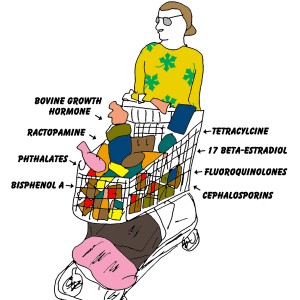While researchers and scientists investigate the cause of our diabetes, obesity, asthma and ADHD epidemics, they should ask why the FDA approved a livestock drug banned in 160 nations and responsible for hyperactivity, muscle breakdown and 10 percent mortality in pigs, according to angry farmers who phoned the manufacturer.
The beta agonist ractopamine, a repartitioning agent that increases protein synthesis, was recruited for livestock use when researchers found the drug, used in asthma, made mice more muscular says Beef magazine.
But unlike the growth promoting antibiotics and hormones used in livestock which are withdrawn as the animal nears slaughter, ractopamine is started as the animal nears slaughter.
As much as twenty percent of Paylean, given to pigs for their last 28 days, Optaflexx, given to cattle their last 28 to 42 days and Tomax, given to turkeys their last 7 to 14 days, remains in consumer meat says author and well known veterinarian Michael W. Fox.
Though banned in Europe, Taiwan and China–more than 1,700 people were “poisoned” from eating Paylean-fed pigs since 1998 says the Sichuan Pork Trade Chamber of Commerce–ractopamine is used in 45 percent of US pigs and 30 percent of ration-fed cattle says Elanco Animal Health which manufactures all three products.
How does a drug marked, “Not for use in humans. Individuals with cardiovascular disease should exercise special caution to avoid exposure. Use protective clothing, impervious gloves, protective eye wear, and a NIOSH-approved dust mask” become “safe” in human food? With no washout period?
The same way Elanco’s other two blockbusters, Stilbosol (diethylstilbestrol or DES), now withdrawn, and Posilac or bovine growth hormone (rBST), bought from Monsanto in 2008, became part of the nation’s food supply: shameless corporate lobbying. A third of meetings on the Food Safety and Inspection Service’s public calendar in January 2009 were with Elanco, a division of Eli Lilly–or about ractopamine.
In fact, in 2002, three years after Paylean’s approval, the FDA’s?Center for Veterinary Medicine’s Office of Surveillance and Compliance accused Elanco of withholding information about “safety and effectiveness” and “adverse animal drug experiences” upon which ractopamine was approved, in a 14-page warning letter.
“Our representatives requested a complete and accurate list of all your GLP [Good Laboratory Practices] studies involving Paylean® (Ractopamine hydrochloride), including their current status as well as the names of the respective study monitors. In response, your firm supplied to our representatives multiple lists which differed in the names of the studies and their status. In addition, your firm could not locate or identify documents pertaining to some of the studies. This situation was somewhat confusing and created unneeded delays for our representatives,” wrote Gloria J. Dunnavan, Director Division of Compliance.
Where was mention of the farmer phone calls to Elanco reporting, “hyperactivity,” “dying animals,” “downer pigs” and “tying up” and “stress” syndromes, asks the FDA letter. Where was the log of phone calls that included farmers saying, “animals are down and shaking,” and “pig vomiting after eating feed with Paylean”?
But, not to worry. Despite ractopamine’s dangers and the falsified approval documents, the FDA approved ractopamine the following year for cattle–and last year for turkeys.
According to Temple Grandin, Professor of Animal Science at Colorado State University, the “indiscriminant use of Paylean (ractopamine) has contributed to an increase in downer non-ambulatory pigs,” and pigs that “are extremely difficult to move and drive.” In Holsteins, ractopamine is known for causing hoof problems, says Grandin and feedlot managers report the “outer shell of the hoof fell off” on a related beta agonist drug, zilpateral.
A article in the 2003 Journal of Animal Science confirms that “ractopamine does affect the behavior, heart rate and catecholamine profile of finishing pigs and making them more difficult to handle and potentially more susceptible to handling and transport stress.”
Nor can we overlook the effects of “adding these drugs to waterways or well water supplies–via contaminated animal feed and manure runoff– when this class of drugs is so important in treating children with asthma,” says David Wallinga, MD of the Institute for Agriculture and Trade Policy.
The FDA’s approval of a drug for food that requires impervious gloves and a mask just to handle is reminiscent of the bovine growth hormone debacle.
Like rBST, ractopamine increases profits despite greater livestock death and disability because a treated animal does the work of two in a macabre version of economies of scale.
Like rBST, food consumers are metabolic, neurological and carcinogen guinea pigs so that agribusiness can make a profit.
And like rBST, “Mothers Of Growing Children” was not marked as a visiting group on the Food Safety and Inspection Service’s public calendar next to the ag lobbyists.











